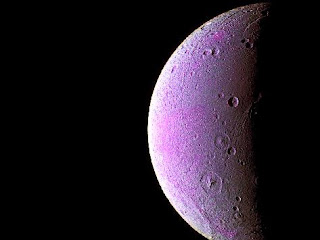 |
| Dione: Moon of Saturn (NASA) |
NASA has found the presence of oxygen in one of the moons of Saturn, Dione. However, the molecular ions is quite a bit, one for each 0.67 cubic inches of space (one for every 11 cubic centimeters of space), or about 2550 per cubic foot (90,000 per cubic meter) - showed that Dion has a very thin neutral atmosphere. Through Cassini spacecraft, the atmosphere of Dione is 300 miles (480 kilometers) above the surface.
"We now know that Dione, in addition to Saturn's rings and the moon Rhea, is a source of oxygen molecules," said Robert Tokar, a Cassini team member based at Los Alamos National Laboratory, Los Alamos, N.M., and the lead author of the paper. "This shows that molecular oxygen is actually common in the Saturn system and reinforces that it can come from a process that doesn't involve life."
Although it is still unknown origin of the oxygen molecule, but provisional estimates may be derived from the bombardment of solar photons or energetic particles from space that strike the surface of water ice on Dione.
Dione's oxygen appears to derive from either solar photons or energetic particles from space bombarding the moon's water ice surface and liberating oxygen molecules, Tokar said. But scientists will be looking for other processes, including geological ones, that could also explain the oxygen.
"Scientists weren't even sure Dione would be big enough to hang on to an exosphere, but this new research shows that Dione is even more interesting than we previously thought," said Amanda Hendrix, Cassini deputy project scientist at NASA's Jet Propulsion Laboratory, Pasadena, Calif., who was not directly involved in the study. "Scientists are now digging through Cassini data on Dione to look at this moon in more detail."
Interestingly, Dione's atmosphere denser than Earth. Another moon of Saturn, Rhea, based on observations in 2010, also have similar atmosphere like Dione. Density of oxygen on the surface of Dione and Rhea is about 5 trillion times denser than Earth's surface.
Tokar said scientists suspected molecular oxygen would exist at Dione because NASA's Hubble Space Telescope detected ozone. But they didn't know for sure until Cassini was able to measure ionized molecular oxygen on its second flyby of Dione on April 7, 2010 with the Cassini plasma spectrometer. On that flyby, the spacecraft flew within about 313 miles (503 kilometers) of the moon's surface.
Cassini scientists are also analyzing data from Cassini's ion and neutral mass spectrometer from a very close flyby on Dec. 12, 2011. The ion and neutral mass spectrometer made the detection of Rhea's thin atmosphere, so scientists will be able to compare Cassini data from the two moons and see if there are other molecules in Dione's exosphere.
This article has edited by authors of threelas
Post a Comment